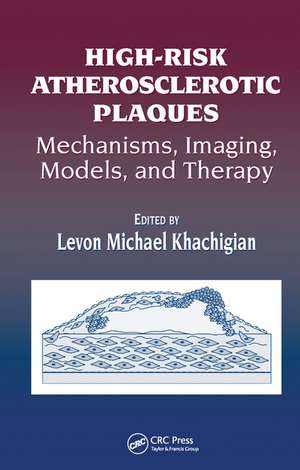High-Risk Atherosclerotic Plaques: Mechanisms, Imaging, Models, and Therapy
Editat de Levon Michael Khachigianen Limba Engleză Paperback – 26 noi 2019
High-Risk Atherosclerotic Plaques: Mechanisms, Imaging, Models, and Therapy brings together timely, in-depth reviews by renowned international cardiologists and scientists. Chapters cover the definition, structure, and cellular and molecular mechanisms of high risk plaque development, as well as animal models of vulnerable plaque, plaque imaging, and current and future therapies. Medical experts discuss intravascular ultrasound, optimal coherence tomography, magnetic resonance imaging, and coronary thermography. The final chapter reviews both current and future local and systematic strategies for the therapeutic management of vulnerable plaque.
Exploring all aspects of this primary cause of acute coronary syndromes, this informative book updates our knowledge on the detection and treatment of vulnerable plaques. It is a valuable resource that can greatly advance the progress in treatment and prevention.
Preț: 340.84 lei
Preț vechi: 454.25 lei
-25% Nou
Puncte Express: 511
Preț estimativ în valută:
65.23€ • 67.85$ • 53.85£
65.23€ • 67.85$ • 53.85£
Carte tipărită la comandă
Livrare economică 14-28 aprilie
Preluare comenzi: 021 569.72.76
Specificații
ISBN-13: 9780367454241
ISBN-10: 0367454246
Pagini: 224
Dimensiuni: 156 x 234 mm
Greutate: 0.42 kg
Ediția:1
Editura: CRC Press
Colecția CRC Press
ISBN-10: 0367454246
Pagini: 224
Dimensiuni: 156 x 234 mm
Greutate: 0.42 kg
Ediția:1
Editura: CRC Press
Colecția CRC Press
Cuprins
Foreword. Cellular and Molecular Mechanisms of Plaque Rupture. Apoptosis and Plaque Vulnerability. Animal Models of Vulnerable Plaque. Diagnosis of Vulnerable Plaques in the Cardiac Catheterization Laboratory. Imaging of the High Risk Atherosclerotic Plaque by Intravascular Ultrasound: Focal Assessment of Morphology and Vulnerability or Systemic Assessment of Disease Burden and Activity? Optical Coherence Tomography for Detection of Vulnerable Plaque. Magnetic Resonance Imaging of "High Risk" Plaque. Nuclear Imaging of the Vulnerable Plaque: Single Photon Emission Computed Tomography (SPECT) and Positron Emission Tomography (PET). Identification of the Vulnerable Plaque: The Role of Thermography. Treatment of Vulnerable Plaque: Current and Future Strategies.
Notă biografică
Professor Levon Michael Khachigian (BSc(Hons), PhD, DSc) is a Principal Research Fellow of the National Health and Medical Research Council of Australia and Head of the Transcription and Gene Targeting Laboratory at The Centre for Vascular Research, University of New South Wales and Prince of Wales Hospital, Sydney. His research, encompassed in over 100 journal articles and book chapters, has greatly increased our understanding of the fundamental transcriptional mechanisms that led to the inappropriate expression of harmful genes in cells of the artery wall. It has also led to his generation of novel DNA-based drugs that block arterial renarrowing after balloon angioplasty in a variety of experimental models. More recently, he has been unravelling the mechanisms behind tumor growth control and other neovascular pathologies by inhibiting angiogenesis. Professor Khachigian has been a major contributor to the broader workings of science on matters of policy, advocacy, consultancy, peer-review, mentorship, and societal service. For example, he is National Executive Director and President-Elect of the Australian Society for Medical Research, and Immediate-Past President of the Australian Vascular Biology Society. He has served on numerous grant review, fellowship, and policy formulation panels for the National Health and Medical Research Council of Australia and the National Heart Foundation of Australia. He sits on the editorial boards of five international journals. Professor Khachigian has won many highly competitive awards for innovative research including the Commonwealth Health Minister’s Award for Excellence in Health and Medical Research, the Gottschalk Award from the Australian Academy of Science, Eureka Prize for Scientific Research from the Australian Museum, RT Hall Prize from the Cardiac Society of Australia and New Zealand, AMGEN Medical Researcher Award, Eppendorf Award for the Young Australian Researcher, Quantum Scientific Research Award, Young Tall Poppy Award, and numerous named research awards for research excellence from the Heart Foundation of Australia. Professor Khachigian received his BSc with first-class honors in biochemistry, and PhD in cell and molecular biology from the University of New South Wales, then studied transcriptional control in the Department of Pathology, Brigham and Women’s Hospital, Harvard Medical School. In 2004, he was awarded a DSc in vascular pathobiology and translational research from the University of New South Wales.
Descriere
Vulnerable plaques are associated with inflammation, apoptosis, rupture, and thrombosis. A detailed understanding of the cellular and molecular pathogenesis of high-risk plaques, together with the ability to visualize and diagnose the lesions, will lead to effective treatments for acute coronary syndromes. High-Risk Atherosclerotic Plaques: Mechani
